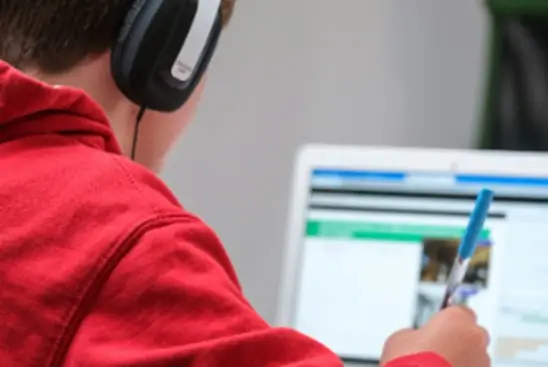Technology is used to offer educational content in digital learning. It is an important part of today’s school system. Digital tools let students and teachers get to materials at any time and from anywhere. This freedom has changed the way we teach and learn.

✅ AI Essay Writer ✅ AI Detector ✅ Plagchecker ✅ Paraphraser
✅ Summarizer ✅ Citation Generator
The digital learning definition dates back to the 1960s when computers were first used in education. The rise of computer-based training in the 1980s and online classes in the 2000s are two important turning points. These days, digital learning includes many different types of tools and platforms, such as e-books and interactive games.
Making sure that online schooling is safe and secure is very important. Protecting students’ private information and upholding the standards of academic honesty are very important. Digital learning can be a strong and safe way to learn if the right steps are taken. In this article, you will find more information about digital learning.
Understanding the Differences: Digital, Online, and E-Learning Explained
Let’s start by answering what e-learning is. Electronic learning, or e-learning, is the process of delivering educational material through digital platforms and electronic devices. You can do this kind of learning online or off, and it usually includes videos, interactive quizzes, and virtual classes. Many people use e-learning for training at work and in higher education.
What is online learning, then? It is a type of e-learning, which is schooling that is done over the Internet. With this method of learning, students can access course materials, take part in conversations, and do their homework online. Because it is flexible and easy to access, online learning is popular for both higher education and job growth.
Both e-learning and online learning are types of digital learning. It includes everything that is done in the classroom that uses digital tools and materials, from tablets to interactive games. Teachers and students can choose the best method for their needs when they know about these differences.
Digital Learning Examples and Practices
Digital learning has changed the way we learn in many creative ways. Here are four well-known digital learning examples and how they are used:
1. Interactive Simulations
Interactive models put students in virtual worlds where they can learn and try new things. With these models, you can learn about science and engineering by practicing the subject without having to use, for example, real tools. For instance, a physics student can learn about motion and force by moving virtual objects around in a controlled digital area.
2. Digital Textbooks
Digital textbooks are an important part of digital material for learning. Most of the time, these e-books have interactive parts like videos, quizzes, and links to other tools. Compared to standard textbooks, they offer a more dynamic way to learn. Biology students watching animations about cell division in their digital textbooks could be an example.
3. Online Courses
One important part of digital learning is taking classes online. Students can learn at their own pace on e-learning platforms that offer courses in many subjects. A lot of the time, these classes have digital learning content such as readings, video lectures, and engaging homework. For example, people who are interested in computer science can take a full course in programming online and learn how to use code by doing tasks.
4. Virtual Classrooms
Virtual classes let students and teachers talk to each other in real-time, just like in a real classroom. Live classes, group talks, and group projects can be made easier with tools like Zoom and Microsoft Teams. Students can join a class from anywhere in the world using this way, which works especially well for remote learning.
The Top Advantages of Embracing Digital Education
You might be wondering: what is the advantage of digital learning, really? Digitized education has many advantages that make learning better for both students and teachers. The main benefits are listed below:
Flexibility and Accessibility
Is there a benefit to learning online? Flexibility is one of the biggest benefits. Students can get to their schoolwork anytime, anywhere, with digital education. For non-traditional students who need to mix their studies with other obligations, like working professionals or people with family duties, this flexibility is especially helpful.
Personalized Learning
Individual students can get educational material that is tailored to their needs on digital learning platforms. Adaptive learning technologies observe how well a student is doing and change the level of effort and the type of material taught based on that. These individualized methods let students study at their own pace and concentrate on areas where they need to enhance their skills.
Enhanced Engagement
Digital learning for students often includes interactive and multimedia-rich content that can make learning more engaging. Gamified learning experiences, engaging simulations, and videos keep students’ attention and make difficult ideas easier to grasp. Active students are more likely to remember what they’ve learned and stay inspired throughout their classes.
Access to a Wealth of Resources
For students, digital education opens up a world of tools that go beyond traditional textbooks. Many educational websites, online libraries, and academic journals provide up-to-date knowledge and different points of view. The ability to access a lot of different materials helps students do more in-depth study and learn more about their subjects.
What Are The Challenges of Digital Education
When we ask what the challenge of digital learning is, one big problem appears— not everyone has access to technology. A digital gap happens when some students don’t have access to good internet or devices. To fix this, schools can get the tools they need and work with nearby businesses and government programs to make the gap smaller.
Digital learning in schools also requires people to know how to use technology, which some students and teachers may not do well with. For everyone to feel safe using digital tools, they need to get a lot of training and ongoing help. Distractions from the internet can also make it hard to concentrate and plan your time. Teaching good study habits and blocking distracting websites can help.
Another problem is the lack of social contact, which can make people feel alone. Using chat boards, live sessions, and virtual group projects can help keep people socially engaged. To get past these problems, it’s also important to make sure that digital learning materials are of high quality and that testing methods are changed to work in a digital setting.
Significance of Secured Digital Education and Optimal Practices
Since digital education is now an important part of modern education, it is important to protect students’ and teachers’ privacy and data with strong security measures. Protecting sensitive information is important to stop data breaches and ensure the safety of an online learning setting as digital learning technologies become more popular. Schools and other organizations must put safety first to build trust and ensure students feel safe.
Teachers and students should create strong, unique passwords for their accounts to keep information safe and private. Using a password manager for this purpose helps greatly. It’s also important to keep your software up to date and be aware of fake scams. Data protection policies should be taught to teachers, and they should only use safe platforms to give digital content. Educational places can make a safe digital learning space for everyone by taking these steps.
Conclusion
What is digital learning, if not a transformative approach that leverages technology to enhance education? By understanding the differences between digital, online, and e-learning, recognizing the benefits, and addressing the challenges, educators can create effective learning environments.
FAQ
Follow us on Reddit for more insights and updates.







Comments (0)
Welcome to A*Help comments!
We’re all about debate and discussion at A*Help.
We value the diverse opinions of users, so you may find points of view that you don’t agree with. And that’s cool. However, there are certain things we’re not OK with: attempts to manipulate our data in any way, for example, or the posting of discriminative, offensive, hateful, or disparaging material.